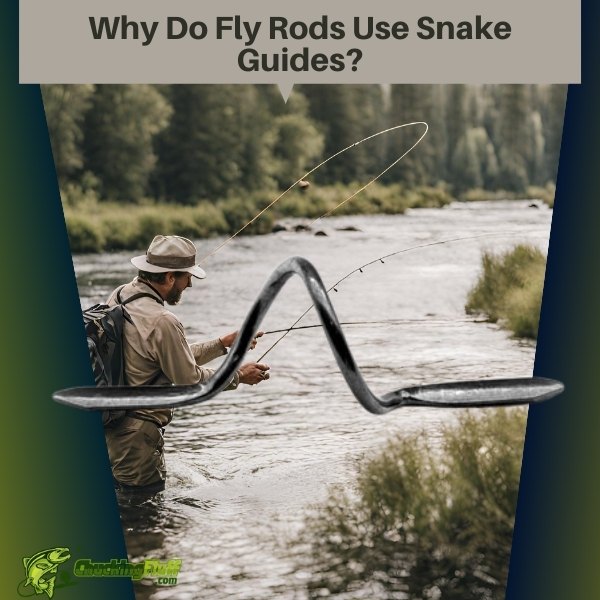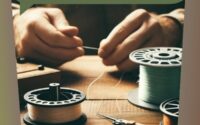| Disclosure: Just to be open and honest the buttons and links you click on in the website will in most cases take you to another website where you can purchase the products I am reviewing. As an Amazon Associate I earn from qualifying purchases. |
Why Do Fly Rods Use Snake Guides? A Friendly Exploration of Their Importance

Hey there, fellow fly fishing enthusiast!
If you’ve ever wondered why fly rods use those small, curvy guides instead of the conventional ones, you’re in the right place.
Snake guides, as they’re called, play a crucial role in fly fishing. In this friendly guide, we’ll unravel the mystery of why fly rods use snake guides, discuss their benefits, explore how to apply them, and answer some common questions.
Quick Post Navigation
Why Using Snake Guides Is a Good Idea:
Section 1: Streamlining Your Cast
Snake guides are essential because they help streamline your cast, making your fly fishing experience smoother and more effective.
Unlike traditional guides with a single foot, snake guides consist of numerous loops that guide your fly line smoothly.
This unique design minimizes friction as the line passes through the guides, allowing your line to glide effortlessly, extending your casting range, and enhancing accuracy.
Imagine your fly line as an arrow in flight. The snake guides create a path for this arrow, reducing disturbances and wobbles, which can occur when the line transitions between guides with single feet.
This streamlined trajectory not only increases your casting distance but also improves the presentation of your fly on the water’s surface, making it appear more natural to the fish.
It’s like having a well-paved highway for your line, ensuring it reaches its destination with minimal turbulence.
Section 2: Distributing Stress and Weight
Another vital benefit of snake guides is their ability to distribute stress and weight evenly along the length of your fly rod.
When you’re battling fish, especially larger and more powerful species, they exert tremendous force on your rod.
Traditional single-foot guides concentrate this stress on a specific point, which can lead to premature wear and even damage to your rod.
In contrast, snake guides evenly spread the load across multiple points along the rod blank.
This not only enhances the rod’s durability but also provides you with more control and leverage when fighting fish.
You’ll feel the rod bending more uniformly, giving you the upper hand during the battle.
Section 3: Enhancing Sensitivity
Sensitivity is a critical aspect of fly fishing, and snake guides play a role in enhancing it.
Due to their minimal contact with the rod blank, they allow you to feel even the slightest nibble or movement of the fly underwater.
This heightened sensitivity is crucial for detecting strikes and ensuring you don’t miss a single opportunity.
When a fish takes your fly, you want to feel it immediately.
Snake guides transmit these subtle vibrations and movements from the line to your hand, ensuring you’re in tune with what’s happening beneath the surface.
This increased sensitivity is particularly beneficial when you’re nymph fishing or fly fishing in situations where fish are finicky and cautious.
Section 4: Minimizing Ice Buildup
Fly fishing isn’t limited to sunny days and warm temperatures.
In colder conditions, traditional guides can suffer from ice buildup, hindering your casting and retrieval.
Snake guides, with their open design, are less prone to ice accumulation.
Picture this: you’re out on a crisp winter morning, and the air is frigid.
Ice crystals can quickly form on the guides of your fly rod, making it challenging to cast and retrieve your line smoothly.
Snake guides, with their smaller surface area and open loops, resist ice buildup more effectively.
This means you can continue fishing comfortably in freezing temperatures without constantly battling frozen guides.
It’s a small but significant advantage for those who enjoy winter fly fishing adventures.
Step-by-Step Guide on Applying Snake Guides:
If you accidentally break off a guide or need to replace one or several this little guide should help you.
Step 1: Gather Your Tools
To apply snake guides, you’ll need a few tools: snake guides, epoxy adhesive, a small brush or toothpick, and a rod wrapping thread.
Step 2: Measuring and Placing Guides
Determine the optimal placement of your snake guides on the rod. Typically, they spaced out evenly over the blank making sure not to hit a connection between sections.
If replacing a broken or missing one the the guide will go back into the place it came out of.
Make sure the old varnish and thread have been removed beforehand.
You can always use a rod-building guide placement chart or seek guidance from a pro if in doubt about placement.
Step 3: Wrapping Thread Application
Secure each guide in place by wrapping the thread around the rod blank.
Make sure it’s snug and evenly spaced.
There are many videos on YouTube showing how to do this.
Step 4: Applying Epoxy Adhesive
Using a small brush or toothpick, apply epoxy adhesive over the thread wraps.
Ensure it’s well-distributed and covers the thread completely.
Step 5: Curing and Finishing
Allow the epoxy to cure as per the manufacturer’s instructions.
Once cured, trim any excess thread, and your snake guides are ready to go!
FAQ’s on Why Do Fly Rods Use Snake Guides?
Q1: Do snake guides work with all types of fly rods?
A1: Yes, snake guides can be used on most fly rods, but the size and placement may vary depending on the rod’s specifications.
Q2: How often should I replace snake guides?
A2: Snake guides are durable, but if you notice any damage or wear, it’s a good idea to replace them to maintain optimal performance.
Q3: Can I install snake guides myself?
A3: Yes, you can install snake guides yourself if you have the necessary tools and some rod-building knowledge.
However, seeking professional help is recommended for best results.
Q4: Are there different types of snake guides?
A4: Yes, there are various materials and designs of snake guides, such as single-foot or double-foot guides, each with its advantages.
Choose the one that suits your fishing style.
Conclusion:
In the world of fly fishing, snake guides aren’t just a design choice; they’re essential for improving your casting, distributing stress, enhancing sensitivity, and ensuring a seamless fishing experience.
Now that you understand why fly rods use snake guides and how to apply them, you’re ready to take your fly fishing game to the next level.
So, embrace the curvy charm of snake guides on your fly rod, and may your lines always glide effortlessly through them, connecting you to the fish beneath the water’s surface.
Happy fishing!


